As a parent, you need to guarantee that the food your kid is eating is safe and fresh. Newborn child food should be appropriately preserved to save its nutritional value and prevent harmful microbes from developing.
Here are a few fundamental rules for keeping baby food — whether prepared or purchased from a store — properly.
1. Choose the Right Containers
It’s fundamental to utilize the right holders to keep baby food fresh. Select glass containers, silicone food storage trays, or BPA-free plastic containers. These materials do not leak dangerous synthetic compounds into the food, making them acceptable for food preservation.
Label Containers
Containers should always have the preparation date labeled. This ensures that you eat the oldest food first and lets you keep track of how long the food has been kept. To prevent smearing, think about using waterproof markers and labels.
Use Airtight Containers
Food deteriorates quicker in airtight containers since they keep air out. Vacuum-sealed bags or containers with tight-fitting covers are extraordinary choices for preserving food freshness over time.
Purchasing a variety of container sizes can likewise be something you need to contemplate. For single servings, smaller containers work best because they ensure that the food is eaten all at once, maintaining its freshness and safety while also reducing waste.
2. Refrigeration
Refrigeration keeps food fresher for extended time frames, but it diminishes bacterial development. Knowing when and how to refrigerate baby food—both homemade and store-bought—is fundamental.
Store Properly
Baby food that has been freshly made or not wrapped should be chilled immediately. Homemade purees must generally keep well in the cooler for as long as 48 hours. According to the producer’s instructions, store-bought baby food should be eaten within 24 to 48 hours of opening and refrigerated.
Temperature
Maintain the temperature of your cooler at or below 40°F (4°C) to preserve food handling and quality. Utilize a refrigerator thermometer to guarantee exact temperature monitoring.
Moreover, baby food should be kept on a fridge shelf rather than in the door, where temperature variations can happen as often as possible because of opening and shutting. This technique supports keeping a consistent temperature, which is fundamental for the safety of food.
3. Freezing Baby Food
Freezing is an incredible method for keeping baby food fresher longer while safeguarding its nutrients and flavors. To keep up with the food’s safety and health benefits, explicit measures should be taken.
Portion Size
Use silicone molds or ice cube pans to freeze baby food in small amounts. After freezing, place the cubes in an airtight container or freezer bag with a label. You may defrost just enough food for each meal by using this method.
Thawing
Use the defrost function on your microwave or the refrigerator to thaw frozen baby food. Never thaw baby food at room temperature since it encourages the spread of bacteria. Make sure you have enough time to thaw the food safely.
Frozen child food can be stored for a limit of 90 days. Name each container with the date it was frozen so you can screen its storage time. Guarantee the food warms to a minimum temperature of 165°F (74°C) to kill any potential microorganisms.
4. Avoid Cross-Contamination
Foodborne illnesses can arise from introducing perilous microbes into baby food through cross-contamination. Thus, it is fundamental to utilize spotless, distinct equipment when preparing and storing meals for infants.
Cleanliness
Ensure your hands, utensils, and prep surfaces are clean before handling baby food. Sanitize all equipment completely with hot, soapy water.
Separate Equipment
Separate cutting boards and utensils should be used for raw meat and child food to prevent cross-contamination. Assuming you want to separate raw meat, organic products, vegetables, and baby food, consider using colored chopping boards.
Also, look out for any drips or spills from raw meats or other possibly hazardous food sources in your refrigerator. Raw meats should be kept on the lowest shelf to forestall contaminating other meals with their fluids, and spills should be tidied up immediately.
5. Proper Handling and Serving
The safety and quality of baby food are influenced by how it is handled and presented. In order to maintain the food clean and safe for your baby to eat, it is imperative that you adhere to best practices.
One-Time Use
Avoid feeding your baby straight out of the storage container. The remaining food could become contaminated by the spoon’s saliva. Instead, feed a portion in a different dish. By using this technique, germs are kept out of the storage container.
Discard Leftovers
Throw away any food that is still unfinished in the dish. Never put it back in its storage container. This is because extra food could become contaminated with microbes from your child’s mouth and be perilous to eat later.
Furthermore, make certain to test the temperature before feeding your baby and whirl the food delicately to prevent hot spots that could burn their lips.
6. Store-Bought Baby Food
Store-bought baby food should be stored in a manner that keeps up with both nutritional value and safety.
Check Expiry Dates
It is fundamental to check the expiration dates when you buy baby food to guarantee it is still safe. Food handling and quality can’t be ensured, so eat something that hasn’t passed its expiration date.
Refrigeration
Store-bought baby food should be refrigerated after it has been opened and utilized within the 24-48-hour time frame listed on the packaging. To keep a consistent temperature, put the container on a fridge shelf with the cover safely shut.
Also, search for indications of tampering or damage to the bundling of the packaging of store-bought baby food. Containers with dents or damaged seals should not be bought as they might be contaminated.
EnsureYour Baby’s Food Stays Fresh and Safe
To keep baby food safe and fresh, it should be stored correctly. You might be certain that you are continuously giving your baby healthy, safe meals as per these guidelines. Continuously make sure to decide in favor of watchfulness and dispose of any food that appears to have turned bad.



